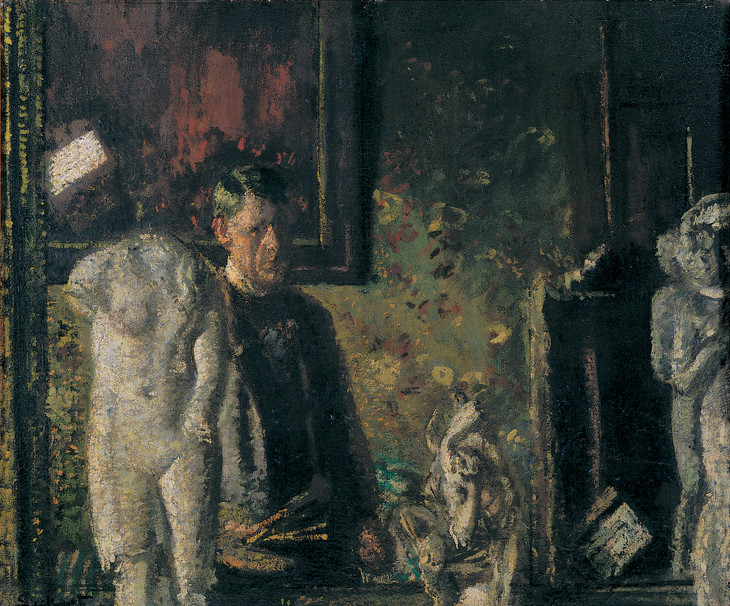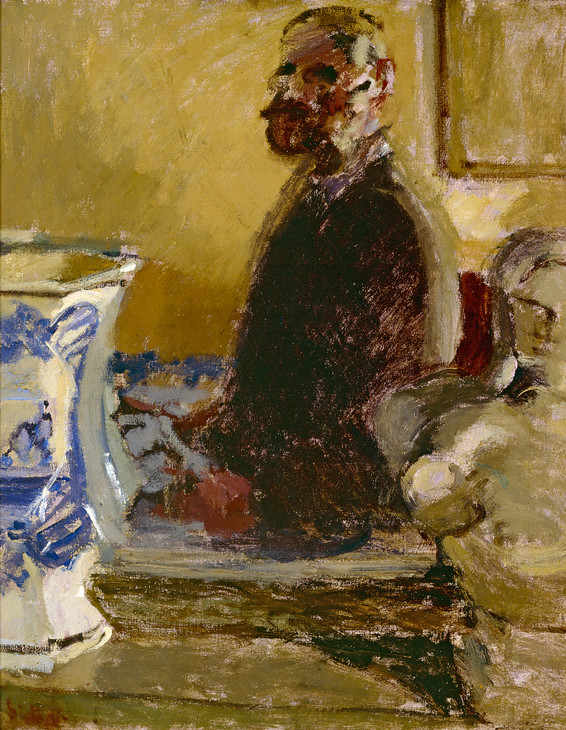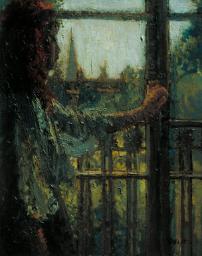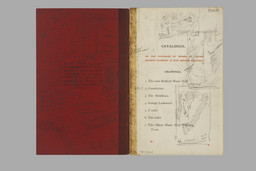Walter Richard Sickert Mrs Barrett c.1905
Walter Richard Sickert,
Mrs Barrett
c.1905
This pastel shares the title of an oil painting by Sickert in which the sitter appears dressed as a coster girl. There is much speculation as to her identity, unrecorded by the artist other than her name. In this picture Mrs Barrett’s neatly coiffed hair, fur stole and pearl necklace imply a more affluent social standing, and are rendered in long streaks of dark colour tones. The distinctive iron bedstead which Sickert kept in his studio can be seen reflected in the square mirror behind her, indicating its setting to be 8 Fitzroy Street.
Walter Richard Sickert 1860–1942
Mrs Barrett
c.1905
Pastel on board
540 x 711 mm
Inscribed by the artist ‘Sickert’ top right
Presented by the Contemporary Art Society 1940
N05127
c.1905
Pastel on board
540 x 711 mm
Inscribed by the artist ‘Sickert’ top right
Presented by the Contemporary Art Society 1940
N05127
Ownership history
Bernheim-Jeune, Paris, c.1909; R.E.A. Wilson; John Lawrence Rayner of the Eldar Gallery, London, from whom purchased by the Leicester Galleries, London, c.1929; J.B. Elliot; sold anonymously, Christie’s, London, 9 February 1934 (3, as ‘Portrait of Mrs Barrett’), bought Helen Lessore; Beaux-Arts Gallery; Redfern Gallery; acquired by the Contemporary Art Society 1939 and presented to Tate Gallery 1940.
Exhibition history
1907
?Exposition Sickert, Bernheim-Jeune, Paris, January 1907 (83, as ‘Le mirroir carré’).
1909
?Vente de 84 Oeuvres de Walter Sickert, Bernheim-Jeune, Hôtel Drouot, Paris, June 1909 (82, as ‘Le mirroir carré’).
1929
Sickert Retrospective Exhibition, Leicester Galleries, London, June 1929 (32).
1939
Selected Paintings, Drawings and Pottery Lent by the Contemporary Art Society, Leicester Galleries, London, October–November 1939 (71).
1942
The Tate Gallery’s Wartime Acquisitions, National Gallery, London, April–May 1942 (118).
1942–3
A Selection from the Tate Gallery’s Wartime Acquisitions, (Council for the Encouragement of Music and the Arts tour), Royal Exchange, London, July–August 1942, Cheltenham Art Gallery, September 1942, Ashmolean Museum, Oxford, October 1942, Galleries of Birmingham Society of Arts, November–December 1942, Fitzwilliam Museum, Cambridge, January–February 1943, Victoria Art Gallery, Bath, February–March 1943, National Museum of Wales, Cardiff, March–April 1943, Manchester City Art Gallery, April–May 1943, Philharmonic Hall, Liverpool, May–June 1943, National Gallery of Scotland, Edinburgh, June 1943, Glasgow Museum and Art Gallery, Kelvingrove, July 1943, Laing Art Gallery, Newcastle upon Tyne, August 1943 (80).
1948–9
The Royal Glasgow Institute of the Fine Arts, Eighty-Seventh Annual Exhibition, McLellan Galleries, Glasgow, November 1948–January 1949 (85).
References
1940
Contemporary Art Society Report 1938–39, London 1940, p.11.
1943
Lillian Browse and Reginald Howard Wilenski, Sickert, London 1943, p.49.
1960
Lillian Browse, Sickert, London 1960, pp.75, 103.
1964
Mary Chamot, Dennis Farr and Martin Butlin, Tate Gallery Catalogues: The Modern British Paintings, Drawings and Sculpture, vol.2, London 1964, p.633.
1973
Wendy Baron, Sickert, London 1973, no.224, p.340.
1992
Wendy Baron and Richard Shone (eds.), Sickert: Paintings, exhibition catalogue, Royal Academy, London 1992, p.160, reproduced fig.125.
2006
Wendy Baron, Sickert: Paintings and Drawings, New Haven and London 2006, no.239.1, reproduced.
Technique and condition
Mrs Barrett is executed in pastel on a grey-green coloured paper laid down on a 5 mm board. Sickert may have worked on the paper and had it lined onto the board later or purchased the support as a composite from an artists’ colourman. He may have initially sketched in the composition onto the paper in a graphic media, such as pencil, before sketching in the portrait in black pastel.
Sickert worked from dark to light using the colour of the paper as a neutral mid-tone. Darker colours and tones were applied first, blocking in with broad strokes that were broken by the rough texture of the paper and working across the full extent of the sheet. Lighter colours and tones were built up over the top so as to retain the purity of colour.
Sickert has used short or hatched strokes to work in more detailed areas of the image on top of the initial blocking in. Finally, he has used sharper black pastel lines to delineate details and define boundaries of space and form. There is a visible border along the edges of the image where the pastel is thinner, suggesting that the artist reworked the portrait after it had been framed. The pastel appears to be unfixed, retaining the grained texture of the pastel applied onto the textured paper.
Sarah Morgan
June 2006
How to cite
Sarah Morgan, 'Technique and Condition', June 2006, in Robert Upstone, ‘Mrs Barrett c.1905 by Walter Richard Sickert’, catalogue entry, May 2009, in Helena Bonett, Ysanne Holt, Jennifer Mundy (eds.), The Camden Town Group in Context, Tate Research Publication, May 2012, https://wwwEntry
The identity of the woman in this pastel has been a subject of complex speculation. In Sickert’s oil titled Mrs Barrett 1906 (private collection),1 what could be the same model – albeit looking perhaps somewhat younger – appears dressed like a coster-girl, with a large, wide-brimmed hat. On a postcard to his friend Elizabeth Swinton, Sickert inscribed a drawing of its composition, ‘Thursday afternoon. New model.’ 1906 (private collection).2 Unfortunately, he does not mention the sitter’s name. In her 1960 Sickert catalogue, Lillian Browse wrote that Mrs Barrett was Sickert’s one-time charlady, but after the catalogue’s publication Mrs Barrett’s daughter-in-law contacted her with a photograph, informing her that Mrs Barrett had been a dressmaker.3 The oil once belonged to Robert Emmons, as did another pastel of the same sitter, which in his lifetime was titled Blackmail. Mrs Barrett 1905 (National Gallery of Canada, Ottawa).4 Seated in a chair, hand on chin, this is quite evidently the same sitter as in the Tate pastel, her hair parted and coiffed in exactly the same way. When Blackmail. Mrs Barrett was unframed, an old Bernheim label and another handwritten one gave the title as Popolana Veneziana, which can be translated as ‘Woman of the Venetian People’. This would seem to contradict the identification of the sitter as Mrs Barrett, unless she was Venetian.
Emmons knew Sickert only from 1927, when he enrolled in his art school at Highbury Place, Islington,5 long after any association Sickert would have had with Mrs Barrett. But as his biographer, in touch with many of Sickert’s circle as well as the artist himself, it is probable that he would have had some corroboration of the sitter’s name in the two works in his collection. In a letter to the Tate Gallery in 1958, Emmons confirmed that, ‘I always thought the sitter for Blackmail was Mrs Barrett’.6 As to Mrs Barrett’s profession, Emmons commented:
I don’t know whether Mrs Barrett was a charlady or not. I am glad you have that wonderful pastel ... I had a good portrait of her in oils, & she did not look like a char.7
An added complication is a letter from Mrs G.E. Brookes, widow of John Lawrence Rayner of the Eldar Gallery, in the Tate Catalogue file.8 She writes that the Tate pastel is almost certainly the same as that once known as The Russian Girl. According to her records this measured 21 x 27½ inches, was in pencil, chalk and wash, and was among the stock of Sickert’s work taken from the art dealer R.E.A. Wilson when her husband started the Eldar Gallery in around 1919. Most of these had been bought by Wilson directly from the artist. All this has led the art historian Wendy Baron to question whether, logically, the pastel might therefore show Elizabeth Swinton, who was born in St Petersburg, although was not actually Russian.9 But Swinton’s different bone structure and age make this identification unlikely, and if the pastel sitter is the same as in the oil Mrs Barrett, then Sickert’s postcard to Swinton about depicting a ‘new model’ would make this identification impossible.
The character of the sitter in the oil painting Mrs Barrett and the Tate pastel does seem markedly different. In the oil she has the look of a working class woman – a ‘woman of the people’ as the Bernheim label suggests. But in the pastel her fur stole or collar and pearl necklace seem to imply a figure of more affluent social standing. It is possible that Sickert was playing with just such emblematic connotations of class, identity and representation. Using his sitter like an actor on a stage, the identity that we think we perceive is based only on superficial pointers to her character and personality.

Walter Richard Sickert 1860–1942
Self-Portrait: The Painter in his Studio 1907
Oil paint on canvas
508 x 610 mm
Art Gallery of Hamilton, Ontario. Gift of the Women’s Committee, 1970
© Estate of Walter R. Sickert / DACS
Photo © Art Gallery of Hamilton, Ontario
Fig.1
Walter Richard Sickert
Self-Portrait: The Painter in his Studio 1907
Art Gallery of Hamilton, Ontario. Gift of the Women’s Committee, 1970
© Estate of Walter R. Sickert / DACS
Photo © Art Gallery of Hamilton, Ontario

Walter Richard Sickert 1860–1942
Self-Portrait: The Bust of Tom Sayers 1913
Oil paint on canvas
610 x 503 mm
Ashmolean Museum, Oxford
© Estate of Walter R. Sickert / DACS
Photo © Ashmolean Museum, Oxford
Fig.2
Walter Richard Sickert
Self-Portrait: The Bust of Tom Sayers 1913
Ashmolean Museum, Oxford
© Estate of Walter R. Sickert / DACS
Photo © Ashmolean Museum, Oxford
The subject and style of the pastel also positions itself alongside contemporary French art. The long streaks of colour with which it is drawn appear deliberately to recall the pastels of Edgar Degas, and also the intimacy of pictures by Bonnard.
The mirror in the background indicates that this might be the pastel exhibited at Bernheim-Jeune in 1907 and 1909 as Le Mirroir carré (The Square Mirror). Bernheim’s stated dimensions of 53 x 69 cm are close enough to make this a possibility.19
Robert Upstone
May 2009
Notes
Reproduced in Wendy Baron, Sickert: Paintings and Drawings, New Haven and London 2006, no.267 and Sickert: Paintings, exhibition catalogue, Royal Academy, London 1992 (52).
See Royal Academy 1992 (45). Although Elizabeth Swinton was born in Russia, she was in fact English, not Russian, an assumption Sickert made when he first met her. See Sturgis 2005, p.347.
See Anna Gruetzner Robins in Degas, Sickert and Toulouse-Lautrec: London and Paris 1870–1910, exhibition catalogue, Tate Britain, London 2005, pp.169–71.
Lionello Venturi, Cézanne, son art – son oeuvre, Paris 1936, no.706; reproduced in Cézanne, exhibition catalogue, Tate Gallery, London 1995 (163).
Adrien Chappuis, The Drawings of Paul Cézanne: A Catalogue Raisonné, Greenwich, Connecticut 1973, no.980; reproduced in Tate Gallery 1995 (111).
Reproduced in Ruth Bromberg, Walter Sickert Prints: A Catalogue Raisonné, New Haven and London 2000, no.210.
Related biographies
Related catalogue entries
Related archive items
-
Drawings by Walter Sickert January 1911Exhibition catalogue
How to cite
Robert Upstone, ‘Mrs Barrett c.1905 by Walter Richard Sickert’, catalogue entry, May 2009, in Helena Bonett, Ysanne Holt, Jennifer Mundy (eds.), The Camden Town Group in Context, Tate Research Publication, May 2012, https://www




